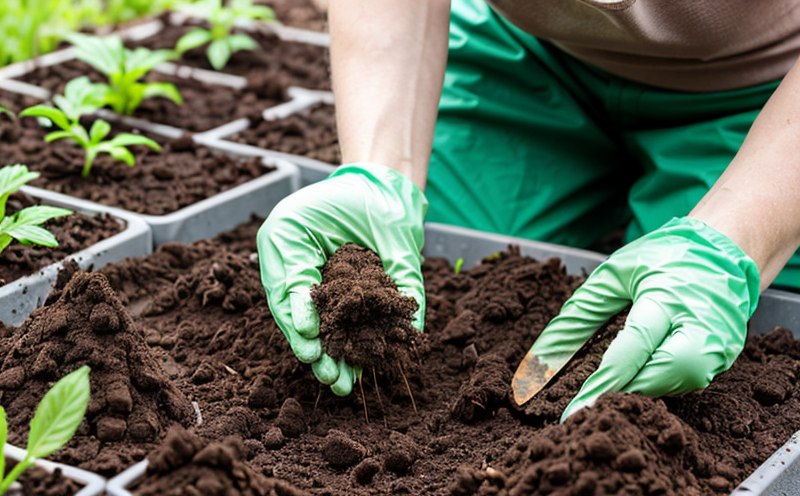IEC 62631 Dielectric Properties Testing of Gardening Plastics
The International Electrotechnical Commission (IEC) standard IEC 62631 provides a comprehensive framework for evaluating the dielectric properties of materials used in electrical applications. In the context of gardening plastics, this test is particularly important as it ensures that plastic components such as irrigation systems, greenhouse structures, and other outdoor equipment are safe from electrical hazards while maintaining their structural integrity.
The dielectric property tests conducted under IEC 62631 measure the ability of a material to store electrical energy in an electric field. This is crucial for gardening plastics because it helps determine how well the plastic will insulate against unwanted electrical current flow, which could lead to short circuits or other safety hazards.
Testing involves subjecting samples of the plastic to various voltages and observing their behavior over time. The results provide insight into the thermal stability, mechanical properties, and chemical resistance of these materials under electrical stress conditions. This information is invaluable for quality managers who need to ensure that products meet regulatory requirements and perform reliably in outdoor environments.
For R&D engineers, this test allows them to innovate by understanding how different types of plastic respond to changing environmental factors like temperature fluctuations and humidity levels. They can then optimize formulas and formulations based on these findings, leading to improved product performance and longevity.
Compliance officers benefit from knowing that their products comply with international standards, thereby reducing the risk of recalls or non-compliance penalties. Procurement teams can also use this information when selecting suppliers who adhere strictly to quality control practices, ensuring consistent delivery of high-quality materials.
The methodology behind IEC 62631 includes both static and dynamic measurements of dielectric constants and loss factors across different frequencies. These parameters help assess the suitability of a given plastic for specific applications within the gardening sector. Understanding these nuances enables stakeholders to make informed decisions about material choices, ultimately enhancing product safety and efficacy.
By adhering to this standard, manufacturers demonstrate their commitment to producing reliable and safe products that meet global standards. This not only builds trust with end users but also opens up opportunities for international trade and collaboration within the industry.
Why It Matters
The importance of dielectric property testing cannot be overstated, especially when it comes to gardening plastics used in electrical components like irrigation systems or greenhouse structures. Ensuring that these materials have appropriate insulation properties is critical for preventing accidents caused by accidental contact with live circuits.
Gardening environments are often exposed to various elements such as rain, sunlight, and wind, which can affect the durability of plastic components over time. By conducting IEC 62631 tests, manufacturers ensure that their products maintain their insulating capabilities even under harsh conditions. This contributes significantly to overall safety standards in horticulture practices.
Moreover, compliance with international standards like IEC 62631 enhances the reputation of companies operating within this sector. It signals to consumers and regulators alike that they are investing in products manufactured according to recognized best practices. Such recognition fosters confidence among buyers who prioritize reliability and safety when purchasing equipment.
From an operational perspective, meeting these standards helps streamline production processes by providing clear guidelines on what constitutes acceptable performance levels for dielectric properties. This reduces the likelihood of costly rework or scrap during manufacturing stages while improving overall efficiency throughout supply chains.
Industry Applications
| Application Area | Description |
|---|---|
| Irrigation Systems | Testing ensures that the plastic components used in irrigation systems are capable of withstanding electrical stresses without compromising functionality. |
| Greenhouse Structures | Evaluating dielectric properties helps in selecting materials that can safely handle potential electrical hazards present in modern greenhouses. |
| Garden Furniture | By assessing the dielectric characteristics, manufacturers ensure that garden furniture remains safe to use even if it comes into contact with electricity sources. |
| Oil & Gas Pipelines | Although not directly related to gardening, some pipeline systems may incorporate plastic components that benefit from IEC 62631 compliance for electrical integrity. |
| Water Treatment Facilities | Incorporating this standard ensures that plastic parts used in water treatment facilities are reliable and safe under various environmental conditions. |
| Solar Panel Frames | The frame material must be dielectrically suitable to prevent short circuits, enhancing the overall efficiency of solar power generation systems. |
| Wind Turbine Blades | Precision in selecting materials based on their dielectric properties is essential for ensuring safe operation and prolonged lifespan of wind turbines. |
The application areas listed above highlight the versatility of IEC 62631 testing beyond just gardening plastics. It plays a pivotal role in promoting safety across multiple industries where electrical components interact with plastic materials.
Competitive Advantage and Market Impact
Adhering to standards such as IEC 62631 provides several competitive advantages for businesses operating in the gardening plastics market. Firstly, it sets a benchmark for product quality that exceeds basic industry expectations, thereby differentiating companies from competitors who may not follow these stringent guidelines.
Secondly, compliance with international standards like IEC 62631 can lead to increased demand for products among consumers and institutions seeking assurance of safety and reliability. This positive reception translates into higher sales volumes and market share gains for compliant firms.
In addition, companies that invest in advanced testing facilities aligned with these standards may gain early access to emerging trends and technologies within the sector. Early adoption often results in faster innovation cycles, giving leaders a head start over laggards.
For procurement teams, ensuring suppliers meet IEC 62631 requirements simplifies supply chain management by reducing risks associated with non-compliant materials. This proactive approach fosters long-term partnerships built on mutual trust and shared objectives towards excellence.
The market impact of such standards extends beyond individual firms; they contribute to broader industry growth through increased investment in research and development aimed at improving product quality and safety. Ultimately, this collective progress benefits all stakeholders by fostering a more robust and resilient sector capable of meeting evolving challenges head-on.





